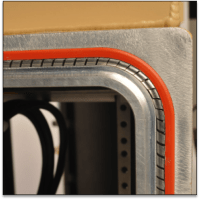
Modern electronics are very vulnerable to Electromagnetic Interference (EMI), sometimes called Radio Frequency Interference (RFI). It’s not just lightning strikes, whose destructive potential is well known. Radar pulses, radio and microwave emissions, cellphones, wireless routers, and the humble microwave oven can affect microprocessor-based systems. It disturbs timing and corrupts data.
In many applications, this is just a nuisance. But, there are times when data loss can be serious – even catastrophic. In such situations, the solution is to place the electronics in a case designed to minimize EMI.
Most people are familiar with their cellphone dropping a call as they step into an elevator. That happens because radio signals can’t penetrate the metal walls. It’s a phenomenon known as a “Faraday Cage”. It’s named after the famed English scientist Michael Faraday. He showed in the 1830s how a metal enclosure can protect an occupant from lethally-high voltages.
The way this works is, metal, being a conductor, allows electrical charges to move around freely. In the case of an enclosure, the charges stay on the exterior surfaces, rather than flow to the inside. This is why a car and airplane are safe places to ride out a thunderstorm. While they may be struck, being electrically conductive, the charge stays on the outside.
The Faraday Cage is sometimes demonstrated by sitting a volunteer inside one of the spheres of a Van der Graff generator. The device builds up a huge electrical charge between two metal spheres. This sparks bolts of lightning, leaping the gap between them. If the volunteer does not touch the exterior skin of the sphere, they will survive unscathed. It’s an impressive demonstration. However, it doesn’t quite explain how radio signals are blocked by an elevator.
Radio transmissions are a form of electromagnetic energy just like microwaves, x-rays and light but travel at a different wavelength. Being electromagnetic, they cause electrical charge to build and move around on the outside, just as lightning does. So rather than penetrating inside, radio signals from the nearby cell tower create a charge on the elevator’s metal skin. This will temporarily turn your smartphone into a paperweight.
When electronic systems need shielding from EMI, the solution is to place them in an electrically-conductive enclosure. By acting as a Faraday Cage, this keeps radio emissions outside and allows the delicate components inside to do their job.
See our selection of EMI Shielded Cases here.
See Part 2 – Cases that Protect Against EMI